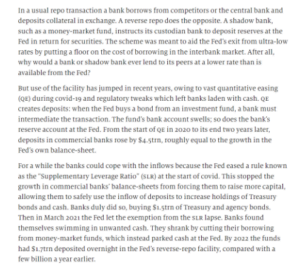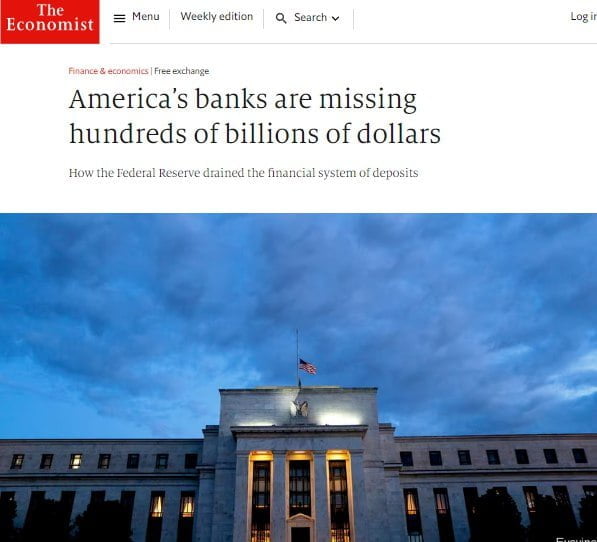The banking saga continues.
In an archived article (https://archive.md/qFfCt) The Economist reported that “deposits are growing scarcer as the system is squeezed—and America’s small and mid-sized banks could pay the price.”
It added that deposits in American banks are declining with commercial bank assets dropping by $500 billion in the last year or nearly 3%. Because banks must become smaller in order to repay their deposits this makes the financial system more fragile.
After the Silicon Valley Bank’s fall “America’s smaller banks fear deposit losses. Monetary tightening has made them even more likely. Use of money-market funds rises along with rates as Gara Afonso and colleagues at the Federal Reserve Bank of New York find since returns adjust faster than bank deposits. Indeed the Fed has raised the rate on overnight-reverse-repo transactions from 0.05% in February 2022 to 4.55% making it far more alluring than the going rate on bank deposits of 0.4%. The amount money-market funds parked at the Fed in the reverse-repo facility—and thus outside the banks—jumped by half a trillion dollars in the same period.”
The Economist goes further to put the blame on the Federal Reserve for draining the financial system of deposits. It explains this through the Federal Reserve’s reverse-repo facility which was introduced in 2013.
“The scheme was a seemingly innocuous change to the financial system’s plumbing that may just under a decade later be having a profoundly destabilising impact on banks.”

But is it the Federal Reserve’s fault? Or was it a planned thing?
The questions that we as laymen have to ask are various. Is it truly the fault of the Federal Reserve? Don’t government bonds which are also tightly linked to a fixed interest rate carry risk too for example and don’t they have prices which can also fluctuate?
Isn’t everything priced in terms of interest rate and time? Haven’t they been trading these things for a long time now?
When you do trading isn’t the fact that the market knows better than you the first thing that you are taught? Doesn’t this mean that you must hedge risks and that it is useless to have any kind of vision that is far more knowledgeable than the market itself? Don’t bankers know this?
But when we say hedging risks don’t we all know that there are various kinds of risks which are interest rate risk credit risk and prepayment risks? So on a treasury or guaranteed bond there is neither any credit risk nor a prepayment risk. Therefore if one hedges out the interest rate risk one is left with zero risk which would be equivalent to zero or nearly zero premium. Wouldn’t this mean that there is no point in doing the trade if one hedges?
How I see it: treasuries are cash and are not meant for banks to make money but they are meant to be a place for banks to put money in when they don’t have anything else to do with it. Banks are supposed to make money from the premium between the base interest rate and the rate on the loans they make. The implied contract when you deposit money in a bank is that the bank has a dependable business model as a lender. They are not supposed to be gambling.
Did Silicon Valley Bank get greedy thinking that ZIRP would continue forever thus making long term bets on that basis and lost? Banks should not be making long bets on macroeconomic conditions. If they do then they are not banks but they are hedge funds.
Another query which we should be making is doesn’t it sound that the reverse-repo market was created so that the Federal Reserve have banks buying securities directly from it when the interest rates were increased? Could it be that Silicon Valley Bank and others just followed the playbook?

